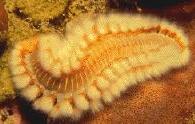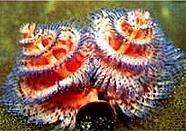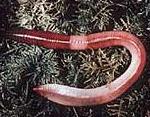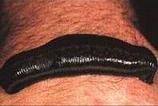
(errant polychaete) |

(sedentary polychaete) |
PHYLUM ANNELIDA*
(The segmented worms; traits from:
|

(oligochaete) |

(leech) |

(errant polychaete) |

(sedentary polychaete) |
PHYLUM ANNELIDA*
(The segmented worms; traits from:
|

(oligochaete) |

(leech) |
===12$==(two+ clades)=== odd tube-building worms (Chaetopteridae, Oweniidae)
|
| =====3= Errantia (active, highly mobile marine worms)
<<=1=| |
| =2=Polychaeta==| =5= bone boring & parasitic Sedentaria (whalebone worms, myzostomids)
| | =4=|
==| =6= typical Sedentaria $$ (tube dwelling or burrowing worms)
|
| =====8============ Oligochaeta (earthworms & relatives)
| |
=7==| ==10===== Acanthobdellida (primitive leech-like annelids)
=====9===|
==11===== Hirudinea (true leeches)
* Struck et al. 2011. Nature 471:95-98 suggest Clitellata may derive from within the Sedentaria (based on 34 annelid taxa, using 47,953 amino acid positions).
Back to Zool 250 tree for animal phyla or Protostomia
TRAITS SUPPORTING EACH CLADE (** plesiomorphic- a primitive state, not unique to clade) AND HIGHER TAXA:
|
b) simple prostomium & pygidium** c) peristomium: a unique pre-segment surrounding the mouth d) no parapodia** e) multiciliated cells** f) chitinous setae in setal sacs** g) each seta secreted by a single cell h) 4 setal bundles per segment (2 dorsolateral, 2 ventrolateral) i) separate sexes, gametes from body wall (no permanent gonads)** j) segmented ventral nerve cord** k) closed circulatory system with capillaries and contractile vessels or hearts l) nephridia with nephrostome opening in segment anterior to nephridiopore m) trochophore larva** b) parapodia c) gametes from body wall (no permanent gonads)** d) complex prostomium e) nuchal organs (sensory) f) 1 pair pygidial setae b) aciculum in each parapodial lobe c) dorsal and ventral cirri on parapodium d) 2 - 3 pairs of anatennae on prostomium e) pharynx with jaws (most) b) jaws usually absent b) grooved feeding palps on prostomium |
b) simple prostomium** c) no parapodia** d) hermaphroditic e) clitellum (produces the cocoon in which eggs are laid) f) permanent gonads in a few segments g) trochophore larva lost b) typhlosole (earthworms) b) single large coelom due to loss of septae between body segments c) fixed number of body segments d) setae restricted to a few anterior segments e) posterior (and often anterior) sucker f) dorsal anus anterior to posterior sucker g) superficial annuli in body wall h) unpaired, mid-ventral male gonopore b) prostomium and peristomium lost c) setae restricted to a few anterior segments** d) body of 29 segments b) body of 33 or 34 segments c) coelom unsegmented d) no setae e) unpaired female gonopore \ |